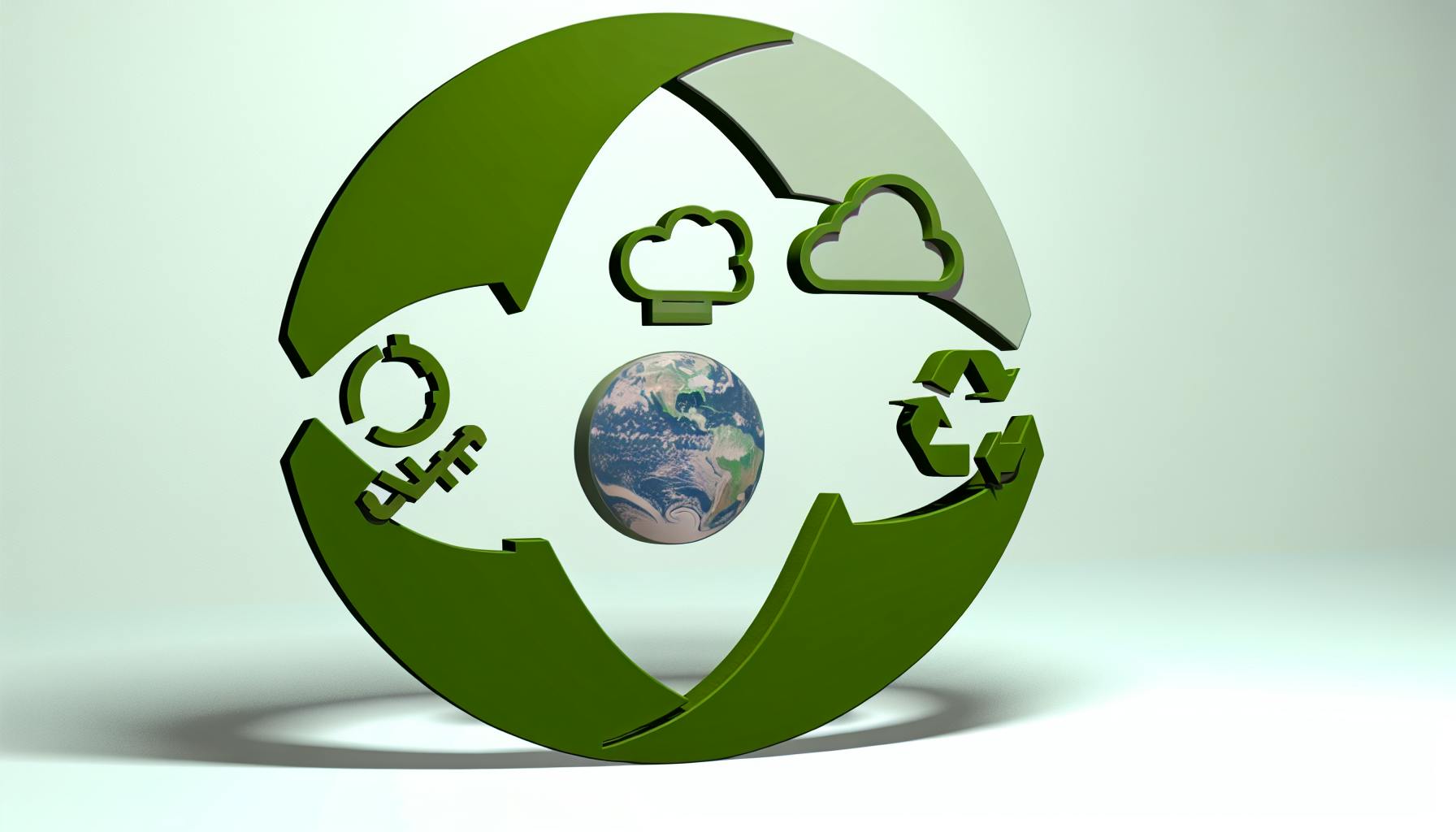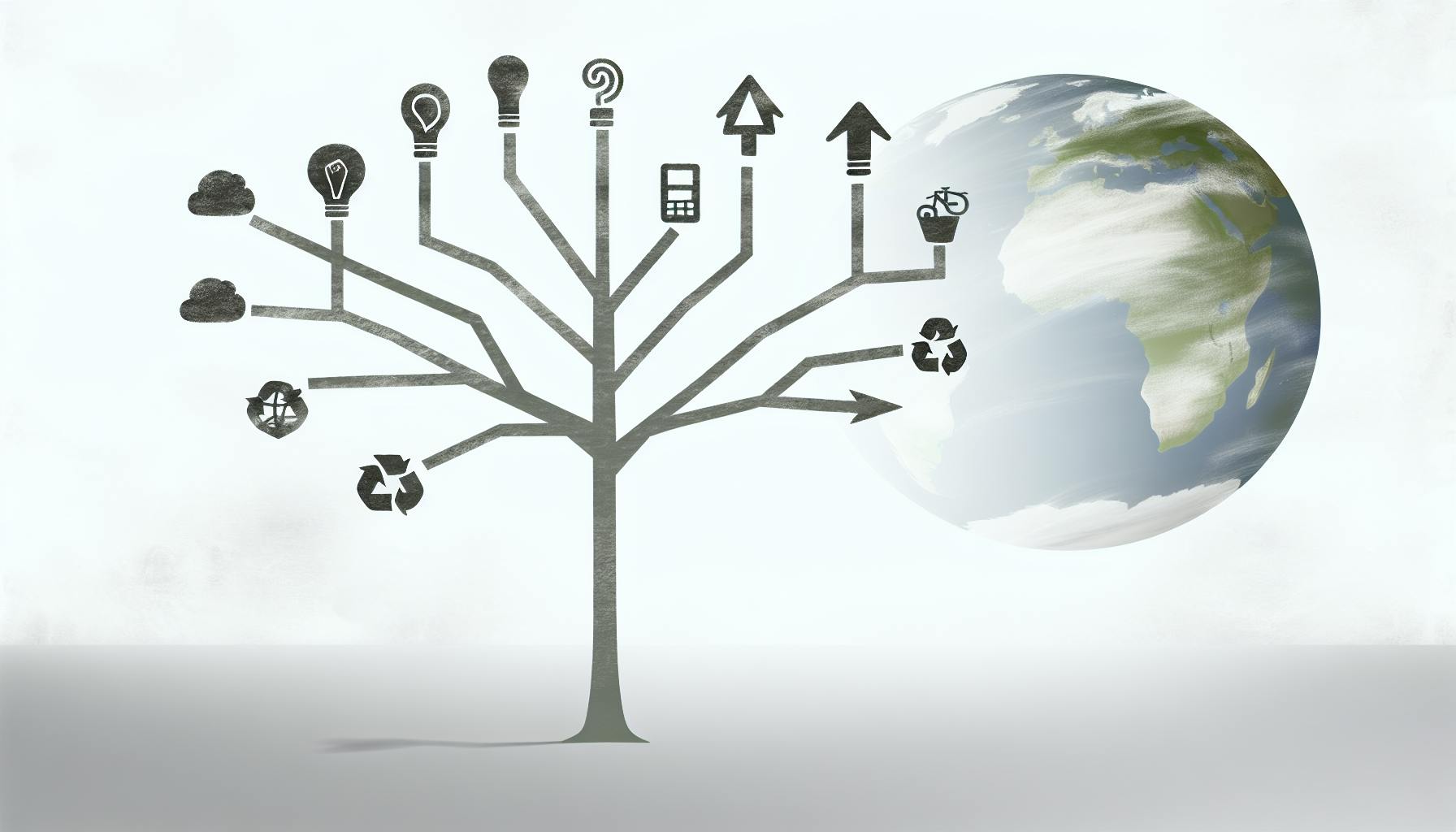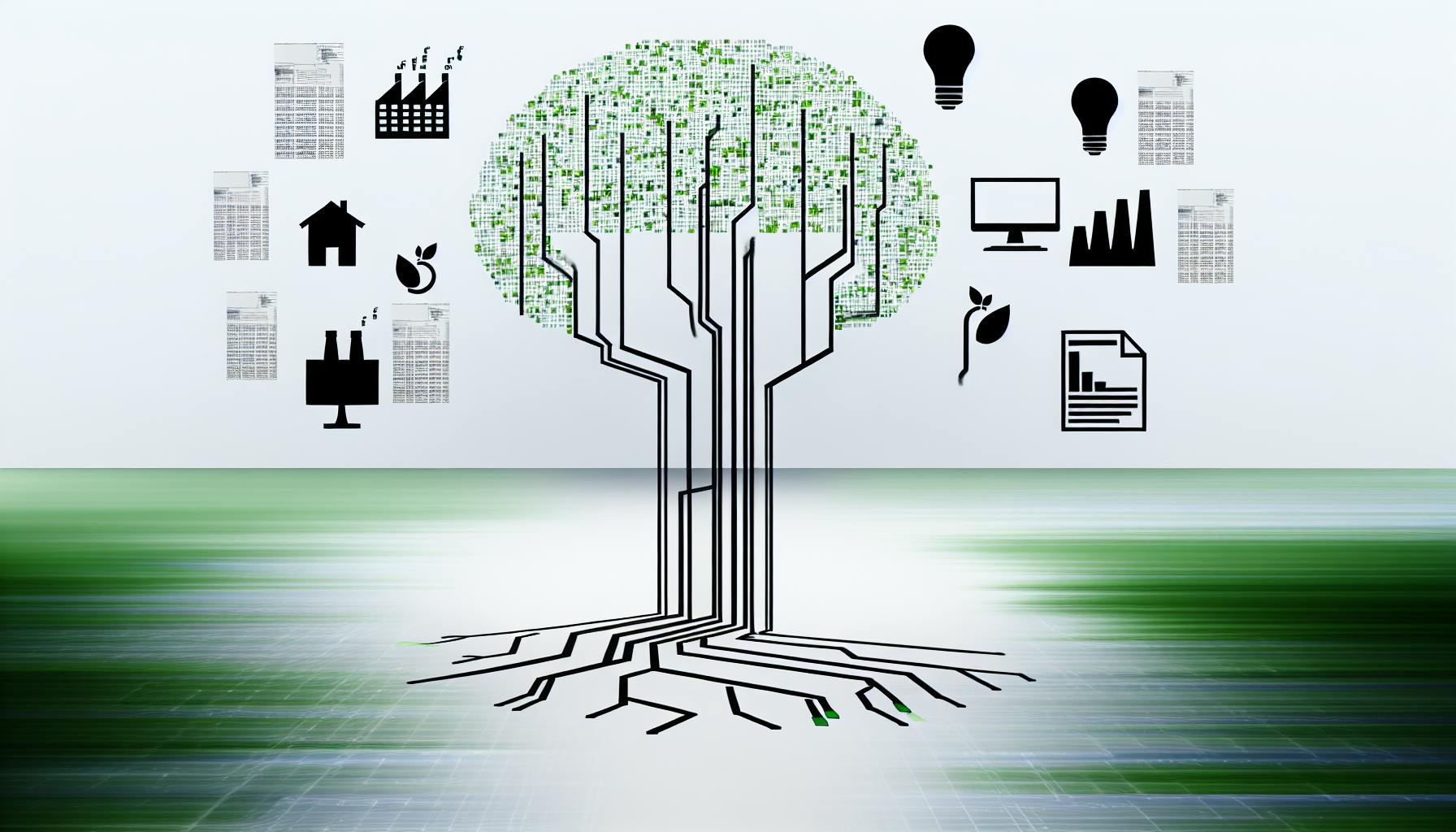In today's climate-conscious world, it's crucial for businesses to manage their carbon emissions effectively. Leveraging technology, particularly SaaS platforms like EcoHedge, can streamline this process, offering benefits such as efficient data collection, accurate carbon calculations, and straightforward reporting. Here's a quick overview to guide small and medium-sized businesses:
- Understanding Your Carbon Footprint: It's essential to know the extent of your emissions across Scope 1, 2, and 3 to effectively manage and reduce them.
- Leveraging SaaS Platforms: Tools like EcoHedge can automate the collection and calculation of carbon data, making carbon management more accessible and accurate.
- Setting Reduction Targets: Use technology to compare your performance, set realistic reduction goals, and implement strategies to meet these targets.
- Continuous Tracking and Improvement: With ongoing monitoring, you can measure your progress and make necessary adjustments.
Adopting these technologies not only helps the environment but can also offer significant business advantages, from cost savings to enhanced brand reputation.
What is a Carbon Footprint?
A carbon footprint is basically all the pollution your company creates, which adds to global warming. This is measured in something called tonnes of carbon dioxide equivalent (tCO2e). It includes:
- Scope 1 - Pollution from things you own or directly control, like company cars, boilers, etc.
- Scope 2 - Pollution from the energy you buy, like electricity or heating.
- Scope 3 - Pollution from other stuff related to your business, like travel, buying goods, throwing away trash, etc.
Most of the pollution usually comes from Scope 3. So, it's really important to keep an eye on this part.
Getting Started with Carbon Accounting
Carbon accounting is just a fancy way of keeping track of all the pollution your company causes. You use certain steps and rules to figure this out, following something called the Greenhouse Gas (GHG) Protocol.
Here's how to do it:
- Decide what parts of your company and operations to include
- Find out where the pollution is coming from
- Gather data on these activities
- Use specific calculations to figure out how much pollution you're making
- Put all this information into a report
Doing a good job with carbon accounting can help your business in many ways. It lets you:
- Focus on the biggest sources of pollution to reduce them
- Keep track of how you're doing over time
- See how you stack up against others in your industry
- Understand the risks and opportunities related to climate change
- Share your pollution data with others, which can help with getting loans, entering new markets, etc.
Using SaaS tools can make this whole process a lot easier and faster. These tools use technology to automate tasks, saving you time and effort. This is a smart way to make the most of carbon management for your business, especially if you're aiming for sustainability and reducing emissions on your way to net-zero.
Leveraging SaaS Platforms for Effective Carbon Management
SaaS platforms like EcoHedge are really helpful for small and medium-sized businesses when it comes to keeping track of and lowering their carbon emissions. These platforms do a lot of the heavy lifting by automatically gathering data and doing the math, which makes things more efficient, reduces mistakes, and supports efforts to be more eco-friendly.
Streamlining Carbon Data Collection
EcoHedge can connect to different sources of information, like:
- Energy use from smart meters and utility bills
- Travel records from vehicles and shipping companies
- Details on goods and services bought
- How waste is managed, like recycling and trash
This means all the important data is in one place, so you don't have to manually put it in from different places. It can even work with special data your company might have.
Enhanced Accuracy of Carbon Calculations
After getting the data, EcoHedge uses the latest rules from the GHG Protocol to figure out emissions accurately. It's always updated to make sure it's using the most correct information.
This is better than doing it by hand because:
- It avoids math mistakes
- It uses detailed activity data for more precise numbers
- It can handle complicated math easily
The software also checks the data carefully to catch any odd things before finalising the emissions numbers.
Seamless Reporting and Benchmarking
EcoHedge can automatically make different types of reports for:
- Investor reports to show how the company manages climate risks
- Sustainability reports to talk about how emissions are being reduced
- Regulatory disclosures to meet legal requirements
- Supply chain reports to encourage partners
It also compares your company's performance to others in the same industry to point out where you can do better.
By using EcoHedge, small and medium-sized businesses can get more value from their efforts to manage carbon emissions while using fewer resources.
Implementing a Step-by-Step Technology Solution
Leveraging technology like SaaS platforms can make managing your company's carbon footprint a lot easier. Here's a straightforward four-step guide to help you get started:
Step 1: Assessing Your Carbon Footprint
First, figure out how much carbon your company is actually releasing. Tools like EcoHedge Express can help by:
- Connecting to your company's data sources
- Gathering relevant information
- Calculating emissions based on the latest standards
- Sorting emissions into Scope 1, 2, and 3 categories
This step gives you a clear picture of where your emissions are coming from.
Step 2: Setting Carbon Reduction Targets and Measuring the Impact of Products
Knowing your emissions, you can then conduct lifecycle assessments to see how your products stack up against others. This helps you:
- Understand where you stand
- Spot where you can cut emissions
- Make realistic goals for cutting down
Your goals can match global efforts like the Paris Agreement or be custom-fit for your company.
Step 3: Implementing Reduction Strategies
With clear goals, it's time to start reducing emissions. You can use technology to:
- Plan better routes for your vehicles to cut down on gas
- Keep equipment running efficiently
- Work with suppliers to reduce emissions in your supply chain
Step 4: Continuous Tracking and Reporting
Keeping an eye on your progress and sharing it is crucial. With SaaS tools, you can:
- Keep collecting data to see how you're doing
- Make reports that meet different standards
- Use dashboards to easily show off your progress
Staying on top of your emissions and being open about it builds trust, can help you get green financing, and supports sustainable growth.
Overcoming Key Challenges
Data Collection Hurdles
Getting all the data on emissions can be tough for small and medium businesses because they might not have a lot of people or money to do it. But, technology can make this easier:
- Use automation - Tools like EcoHedge can automatically grab data from different places, making it less of a hassle. They're designed to easily connect with other systems.
- Focus on big sources first - Start by looking at where most of your emissions come from. You don't need to track everything right away. You can add more details as you go.
- Estimate when needed - If you're missing some data, using standard values or spending figures can give you a good guess.
- Get help if needed - Sometimes, hiring experts to gather and look at complex data or teach your team can save money in the long run.
Integrating Systems
Adding new tech to old computer systems needs a plan:
- Check what you have - List out your current systems and how data moves between them. This helps you know what needs to connect to what.
- Use APIs - Many tools like EcoHedge have special connections (APIs) that let them talk to systems you already use, making things easier.
- Start with the most important - First, connect systems that are key to your emissions tracking. Show how this helps, then add more over time. Getting your bosses on board step by step is important.
- Pick easy-to-use tools - Tools that work over the internet don't need fancy computers or software, cutting down on costs.
Building Internal Buy-in
To get everyone on board with new tech for tracking carbon, you need to show how it helps the business:
- Talk about saving money and time - Explain how using tech can make tracking emissions faster and cheaper than doing it by hand.
- Point out legal benefits - Following the rules is getting tougher, and good tracking helps avoid fines.
- Mention better loan terms - Having solid data on your emissions can get you loans with better conditions.
- Highlight advantages with suppliers and customers - You might get discounts, have better relationships with suppliers, and attract customers who care about the environment.
With a smart approach, small and medium businesses can tackle the challenges of adopting tech for carbon management. The trick is to move forward step by step, focusing on how it helps the business.
sbb-itb-0f1f828
Conclusion
Key Takeaways
Here's what small and medium-sized businesses need to remember when using tech to manage their carbon emissions better:
- Keeping an eye on and cutting down carbon emissions is getting more important because of rules and what customers and investors want. If you don't do it, you could fall behind.
- New software can do the heavy lifting in tracking emissions for you. This means you save time and money compared to doing it the old-fashioned way. Plus, it makes reporting a breeze.
- Understanding your carbon footprint clearly helps you figure out the best ways to reduce it and hit your goals. This can also save you money.
- Here's a simple way to start using new tech:
- Find out how much carbon you're emitting
- Decide how much you want to cut down
- Start making changes
- Keep an eye on how you're doing
- You might run into issues like gathering data, making new tech work with old systems, or getting everyone on board. But, you can solve these problems by focusing on how the tech makes things easier and helps the business.
- Real stories from other businesses show that managing carbon emissions with tech can lead to being more eco-friendly, saving money, catching the eye of investors, and looking good to the public.
Starting with small steps and showing the benefits of managing emissions with tech can help get everyone on board. If you do it right, it can lead to both helping the planet and gaining business benefits.
Related Questions
How technology can help reduce carbon footprint?
Using smart tech like AI, tracking systems, and smart devices can help lower carbon emissions by:
- Making buildings and cars use energy more wisely
- Helping power grids manage electricity better
- Boosting the use of clean energy like wind and solar
- Making moving goods around more efficient
- Coming up with new, low-carbon products and ways to do things
- Keeping a close eye on emissions to make sure they're low
- Letting people work together from afar, cutting down on travel
What are the technologies are currently used for reducing the co2 emission?
Important tech for cutting CO2 includes:
- Clean energy sources (like solar panels and wind turbines)
- Electric cars and hydrogen fuel
- Tech to capture and store carbon
- Batteries for storing energy
- Alternatives to regular fuels and plastics
- Systems that control energy use in buildings
- Turning waste into energy and recycling
These options help avoid using fossil fuels in areas like transport, power generation, and manufacturing.
How can we use innovation and technology to decrease co2 emissions to the atmosphere?
To lower CO2 emissions using tech and new ideas, we can:
- Use more renewable energy like sun and wind power
- Get better at storing energy to support clean power
- Switch to electric vehicles and build the needed charging spots
- Use tech to capture carbon in factories and power plants
- Use smart systems and big data to make energy use more efficient
- Create eco-friendly alternatives to common products
- Support new companies working on green solutions
What technology is used to help climate change?
Tech that helps with climate change includes:
- Renewable energy for clean power
- Electric vehicles and other clean transport options
- Smart systems for saving energy in buildings
- Carbon capture tech to remove CO2 from the air
- Tools to deal with climate change effects like new crop types
- Digital systems to track emissions and improve efficiency
These technologies help reduce harmful emissions and make our world more climate-friendly.



.png)


